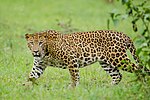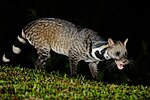 | The large Indian civet (Viverra zibetha) is a viverrid native to South and Southeast Asia. It is listed as Least Concern on the IUCN Red List. The global... 9 KB (1,023 words) - 02:45, 18 March 2024 |
 | The Malabar large-spotted civet (Viverra civettina), also known as the Malabar civet, is a viverrid endemic to the Western Ghats of India. It is listed... 10 KB (1,193 words) - 13:01, 7 May 2023 |
 | The small Indian civet (Viverricula indica) is a civet native to South and Southeast Asia. It is listed as Least Concern on the IUCN Red List because of... 28 KB (2,783 words) - 17:42, 18 April 2024 |
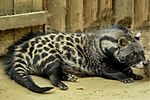 | A civet (/ˈsɪvɪt/) is a small, lean, mostly nocturnal mammal native to tropical Asia and Africa, especially the tropical forests. The term civet applies... 14 KB (1,571 words) - 18:01, 24 March 2024 |
 | The large-spotted civet (Viverra megaspila) is a viverrid native to Southeast Asia that is listed as Endangered on the IUCN Red List. Pocock described... 5 KB (471 words) - 05:39, 15 March 2024 |
 | The Asian palm civet (Paradoxurus hermaphroditus), also called common palm civet, toddy cat and musang, is a viverrid native to South and Southeast Asia... 22 KB (2,495 words) - 05:52, 4 March 2024 |
civet oil in their perineal glands, including the African civet (Civettictis civetta), large Indian civet (Viverra zibetha), and small Indian civet (Viverricula... 6 KB (577 words) - 11:29, 28 September 2023 |
 | The Malagasy or striped civet (Fossa fossana), also known as the fanaloka (Malagasy, [fə̥ˈnaluk]) or jabady, is an euplerid endemic to Madagascar. It... 10 KB (1,050 words) - 11:13, 13 April 2024 |
 | masked palm civet (Paguma larvata), also called the gem-faced civet or Himalayan palm civet, is a viverrid species native to the Indian subcontinent... 17 KB (1,730 words) - 05:53, 4 March 2024 |
 | The African palm civet (Nandinia binotata), also known as the two-spotted palm civet, is a small feliform mammal widely distributed in sub-Saharan Africa... 15 KB (1,713 words) - 16:39, 11 April 2024 |
 | The Malayan civet (Viverra tangalunga), also known as the Malay civet and Oriental civet, is a viverrid native to the Malay Peninsula and the islands of... 9 KB (975 words) - 05:50, 4 March 2024 |
 | viverrids outside the subfamily Genettinae are commonly called civets, but some civets are not viverrids. Animals of the subfamily Genettinae are known... 38 KB (2,334 words) - 09:14, 29 March 2024 |
 | The otter civet (Cynogale bennettii) is a semiaquatic viverrid native to Thailand, Malaysia, Indonesia and Brunei. It is believed to be undergoing severe... 7 KB (639 words) - 05:49, 15 April 2024 |
 | Carl Linnaeus in 1758 as comprising several species including the large Indian civet (V. zibetha). The genus was subordinated to the viverrid family by... 6 KB (487 words) - 09:51, 29 March 2024 |
 | The golden palm civet (Paradoxurus zeylonensis) is a viverrid endemic to Sri Lanka. It is listed as Vulnerable on the IUCN Red List. Its distribution... 9 KB (914 words) - 15:39, 21 April 2023 |
 | Paradoxurus (redirect from Southern palm civet) the Asian palm civet, the Golden palm civet, and the Brown palm civet. Paradoxurus species have a broad head, a narrow muzzle with a large rhinarium that... 7 KB (710 words) - 13:07, 8 March 2024 |
 | Aardwolf (redirect from Civet hyena) termite-eating hyena and civet hyena, based on its habit of secreting substances from its anal gland, a characteristic shared with the African civet. Unlike many... 25 KB (2,850 words) - 18:29, 18 April 2024 |
 | Auguste Pomel in 1853. Its body size equals a large Indian civet, but its dentition resembles that of the Indian grey mongoose. Pomel, A. (1853). "Herpestes... 1 KB (89 words) - 14:53, 6 January 2024 |
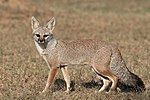 | Bengal fox (redirect from Indian Fox) The Bengal fox (Vulpes bengalensis), also known as the Indian fox, is a fox endemic to the Indian subcontinent from the Himalayan foothills and Terai of... 16 KB (1,868 words) - 01:53, 14 April 2024 |
 | eyes to the first third of the tail. It has large rounded ears and black eyes. is a mid-sized palm civet at 57 cm (22 in) plus a tail of 43 cm (17 in)... 10 KB (1,174 words) - 19:04, 9 April 2024 |
 | List of mammals of Kaziranga National Park (category Use Indian English from July 2018) hare and Indian gray mongoose, small Indian mongoose, large Indian civet, small Indian civet, Bengal fox, golden jackal, Chinese pangolin, Indian pangolin... 9 KB (864 words) - 18:03, 19 August 2023 |
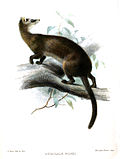 | Hose's palm civet (Diplogale hosei), also known as Hose's civet, is a viverrid species endemic to the island of Borneo. It is listed on the IUCN Red List... 14 KB (1,568 words) - 05:59, 4 March 2024 |
 | macaque Hoolock gibbon Large Indian civet Bengal fox Jungle cat Leopard cat Northern pig-tailed macaque German Shepherd Indian crested porcupine Plains... 6 KB (411 words) - 18:47, 3 March 2024 |





